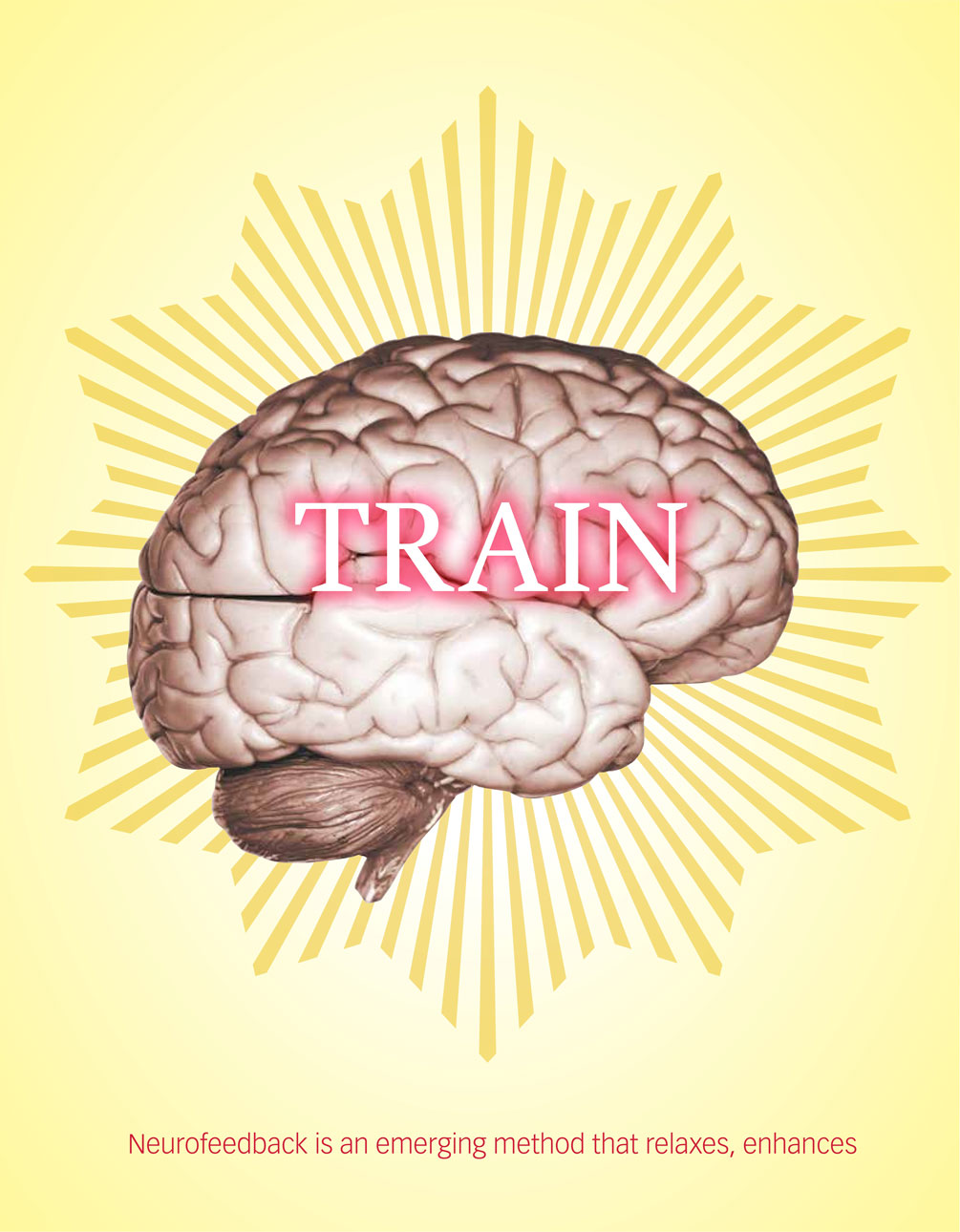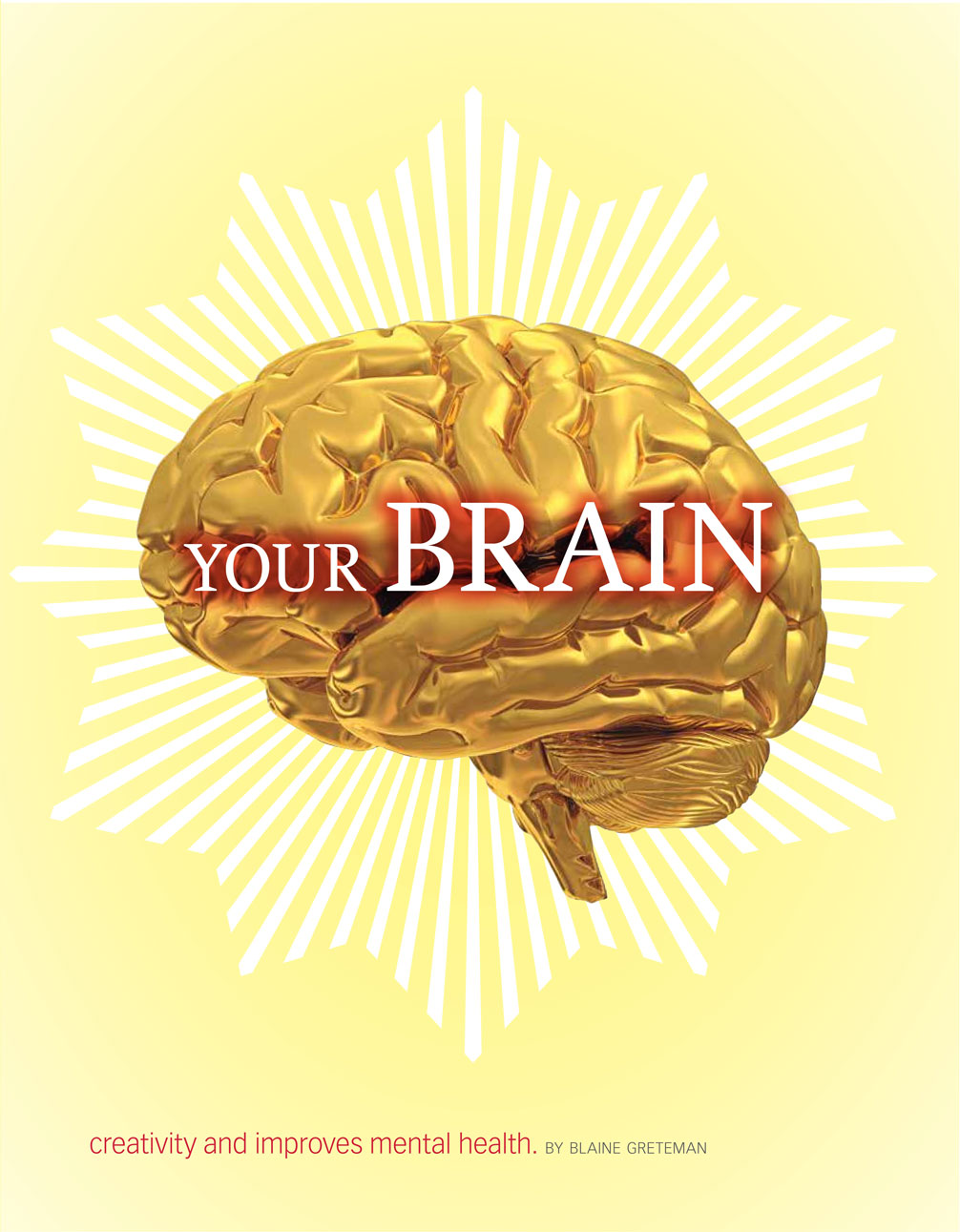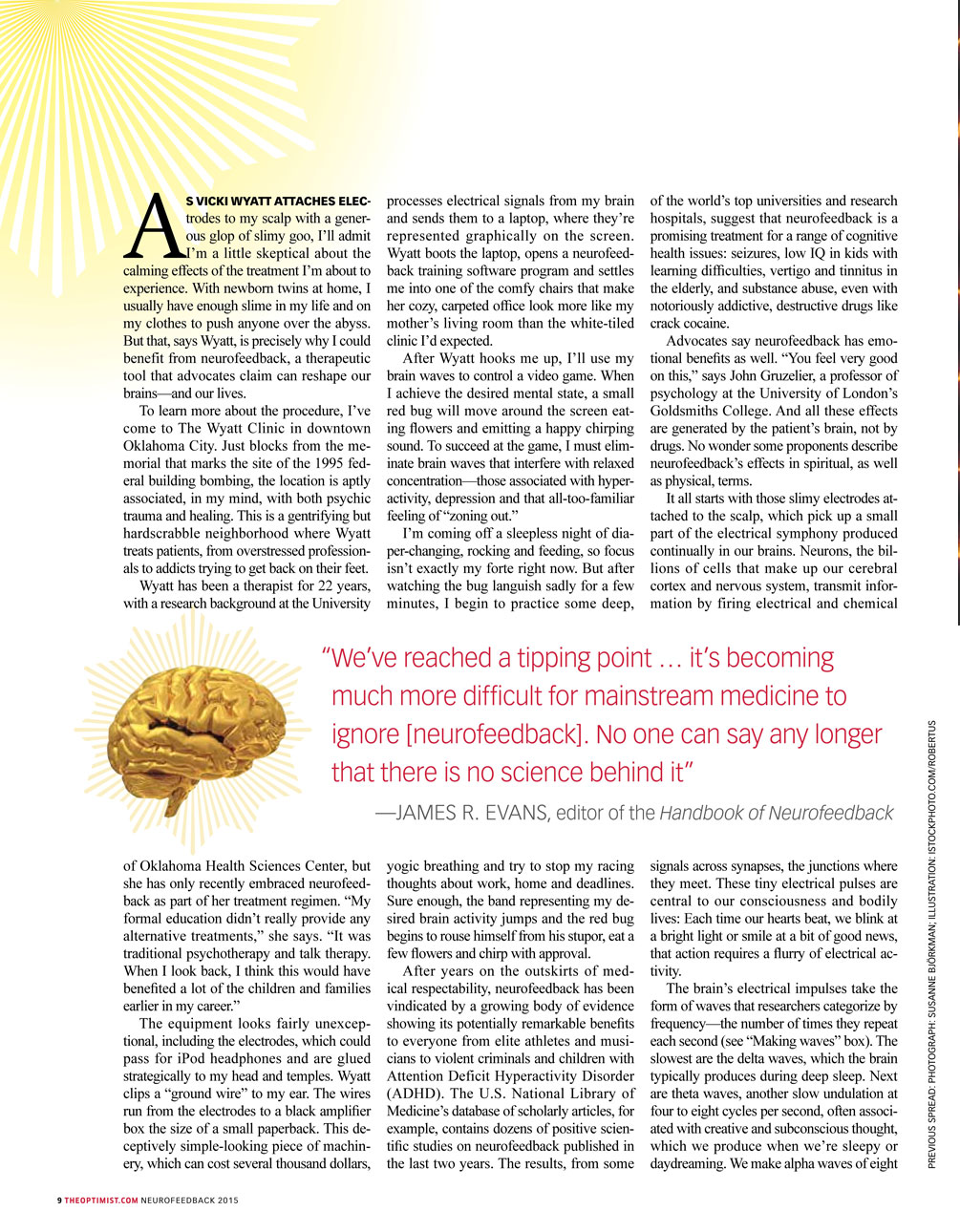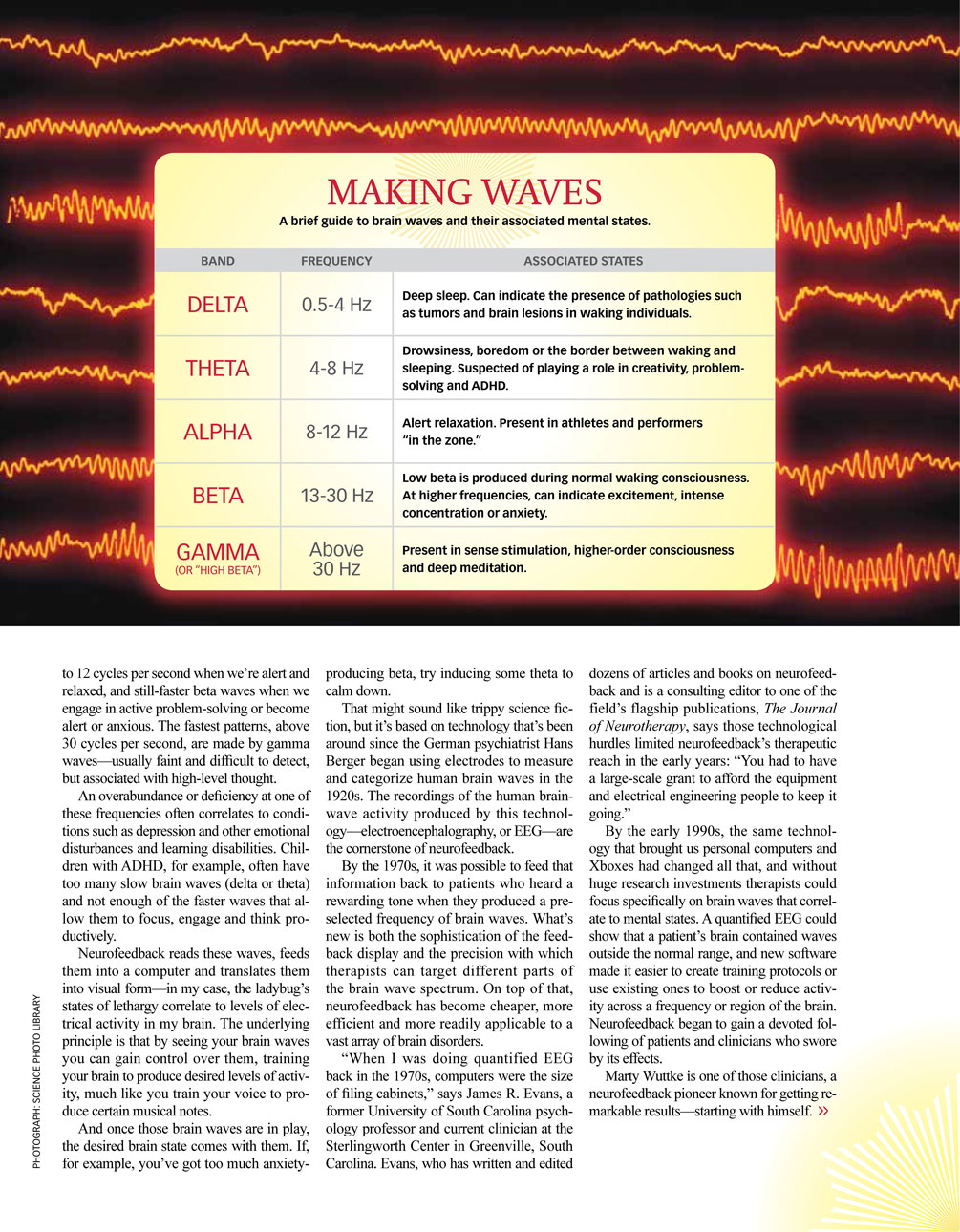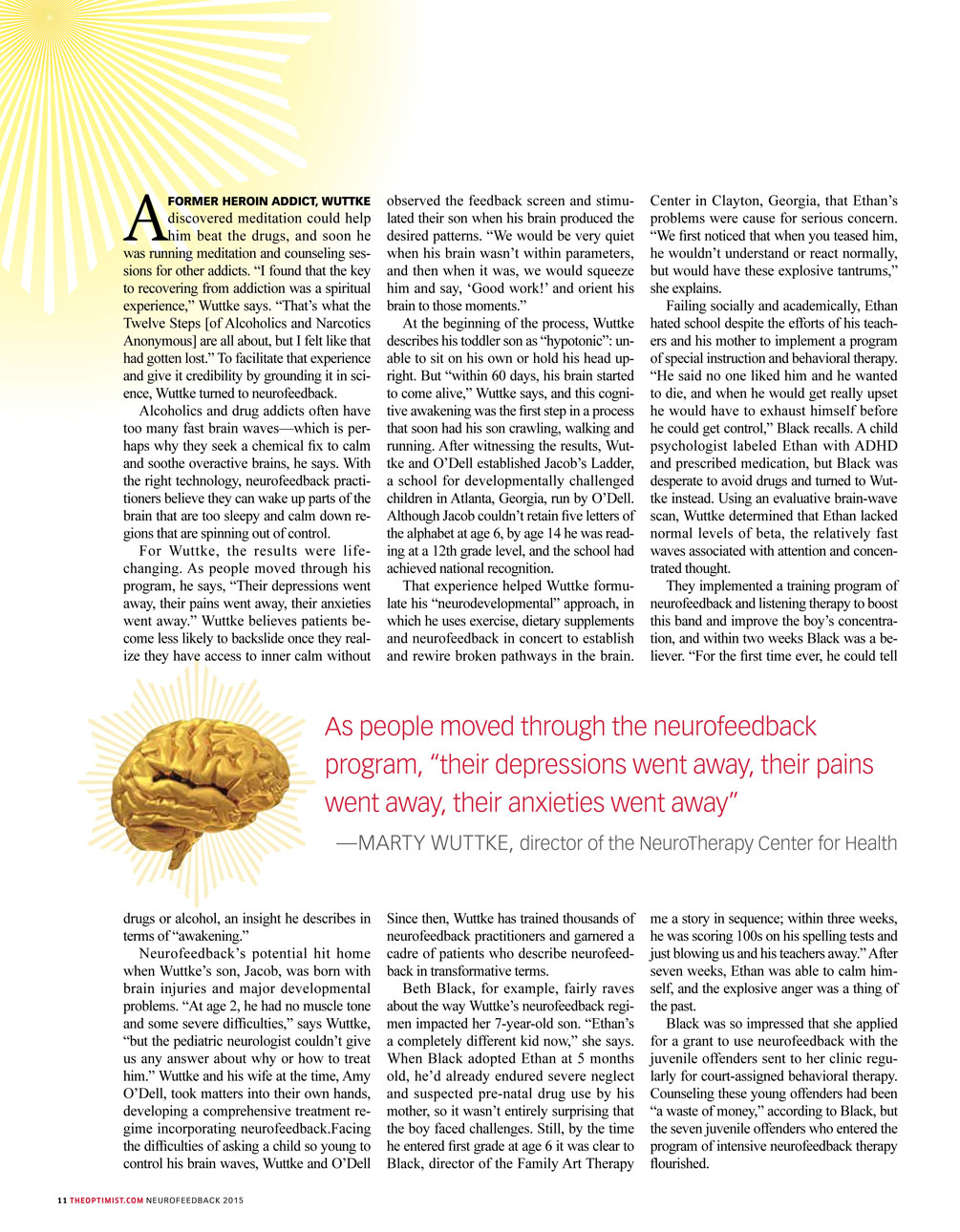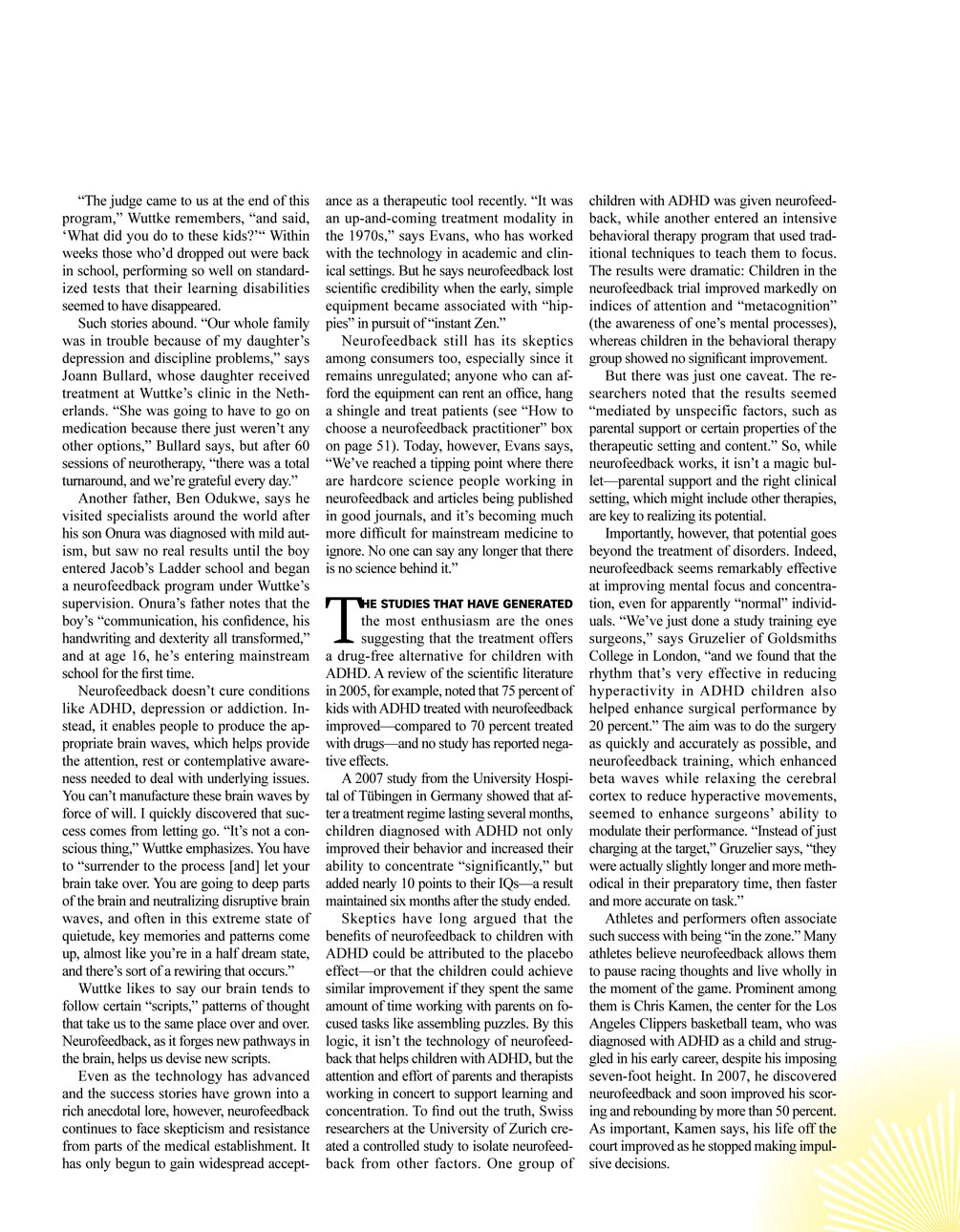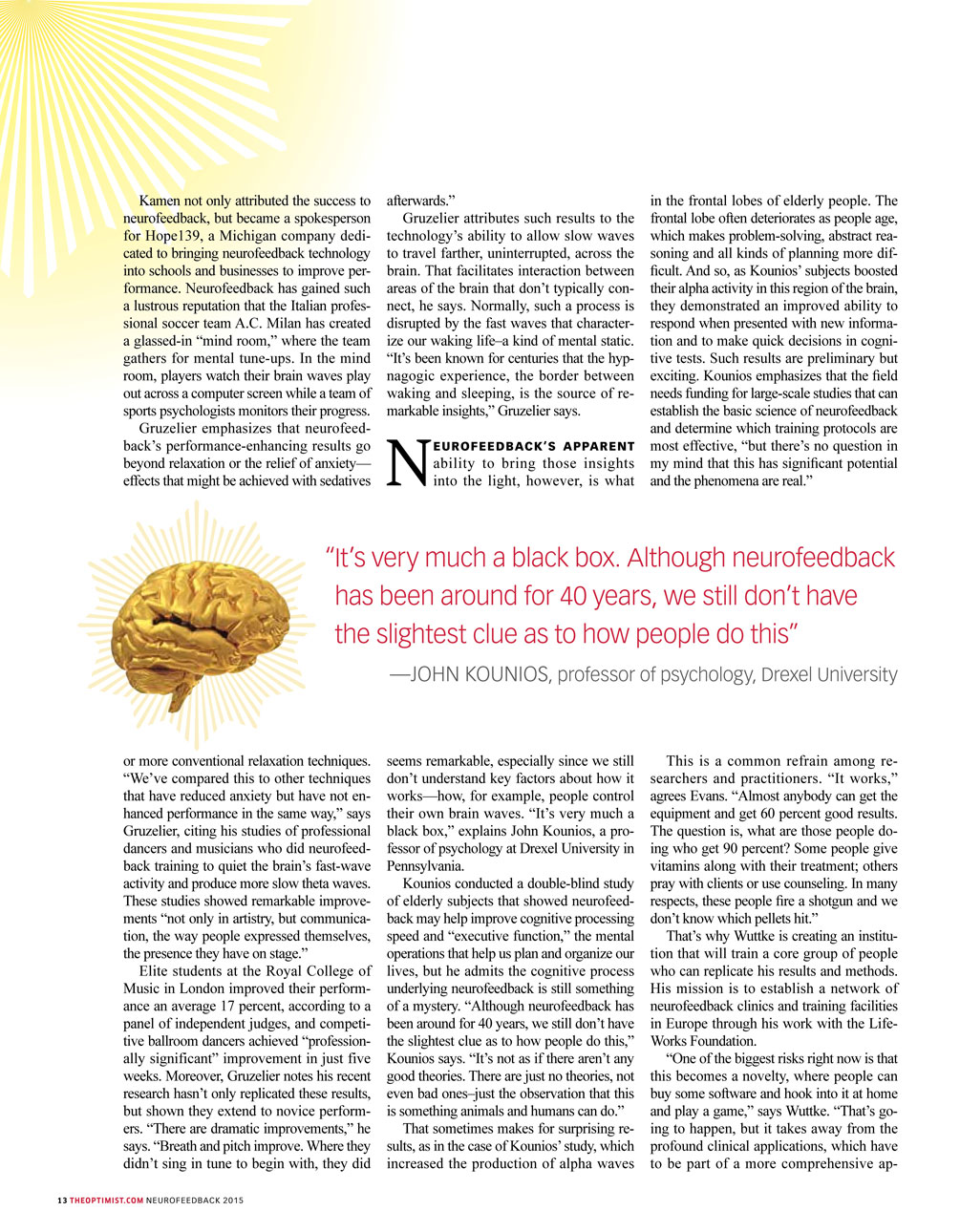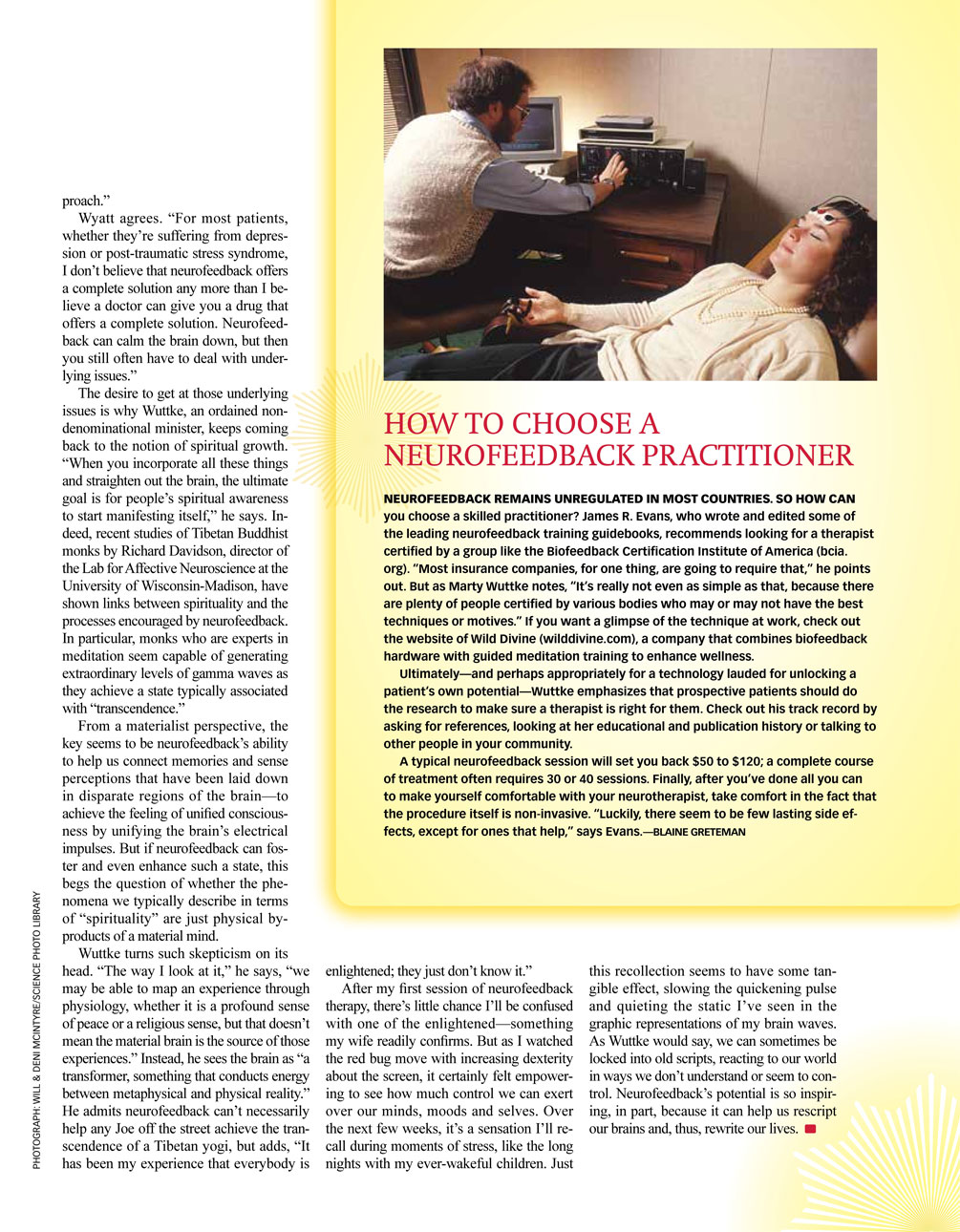
"Rewired and Inspired" by Tijn Touber
Published in Kamp Solutions, Spring 2023, p 34-39.
Modern afflictions like stress, fatigue, anxiety, depression, and hyperactivity can affect the brain. Marty Wuttke has developed a training program that helps harmonize brain frequencies. His treatment removes most of the static so that the brain can heal. A conversation with a pioneer. (https://www.kamp.solutions/)
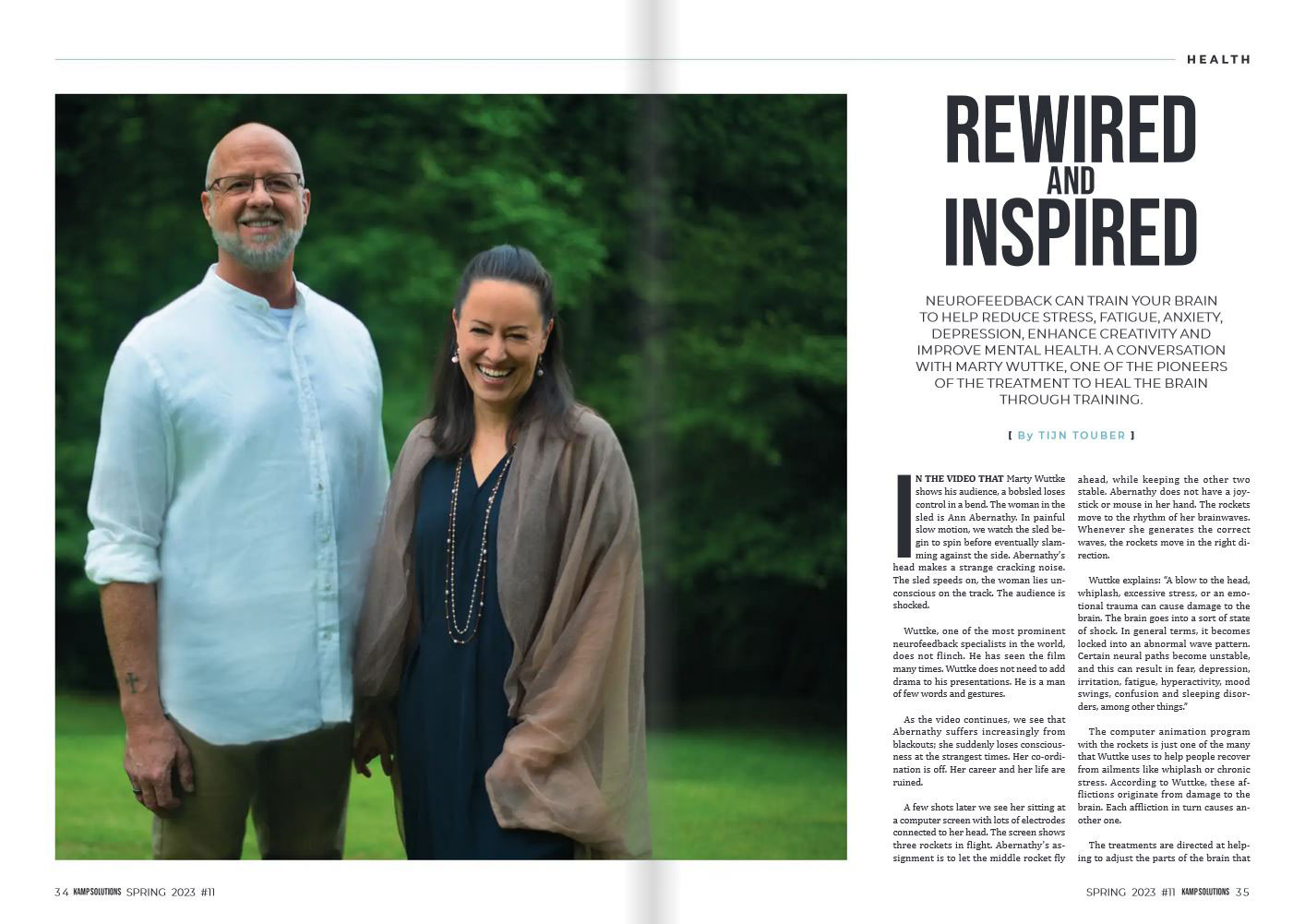
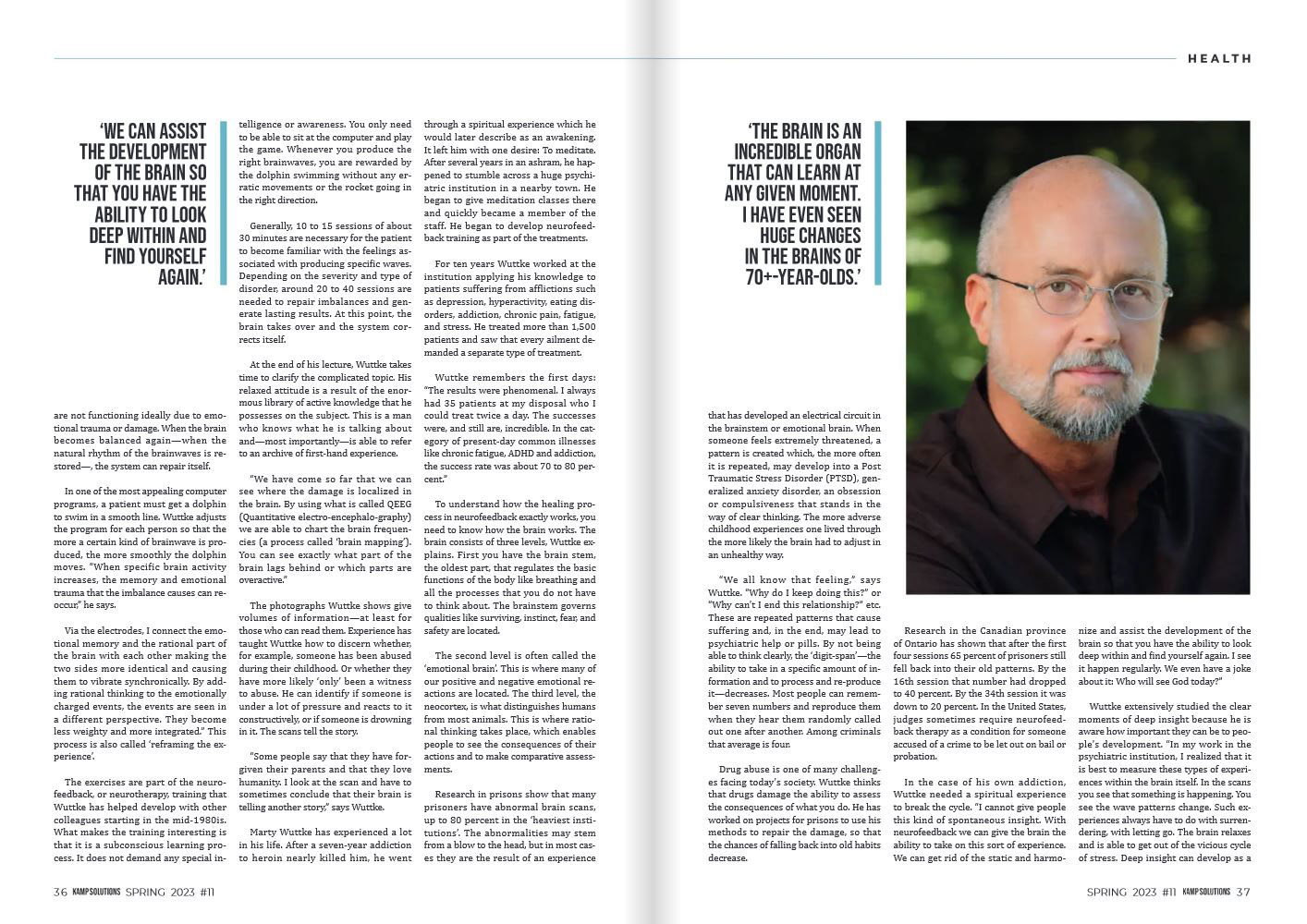
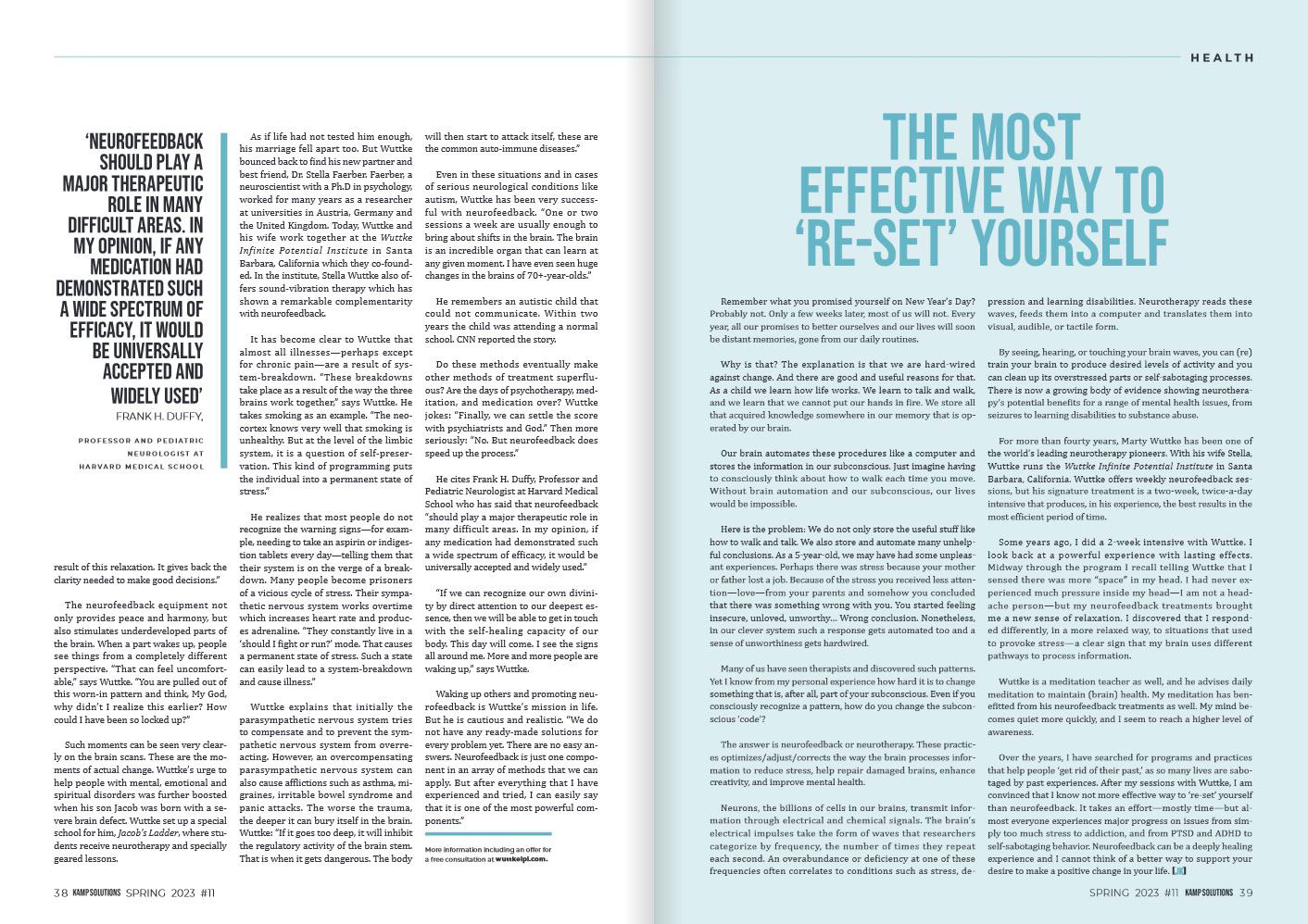

"A Time to Heal" by Anne Brode
Published in The Montecito Journal, 2022, Vol 28 (11)
“The events of the past five years have left an impression on the geography and flow of our community. They have also left an imprint on your personal life. This can show up as an undercurrent of anxiety, heightened sensitivity to criticism, and intolerance for the slightest inconvenience. Even right now, there may be unnecessary […].” (https://www.montecitojournal.net/?s=wuttke)
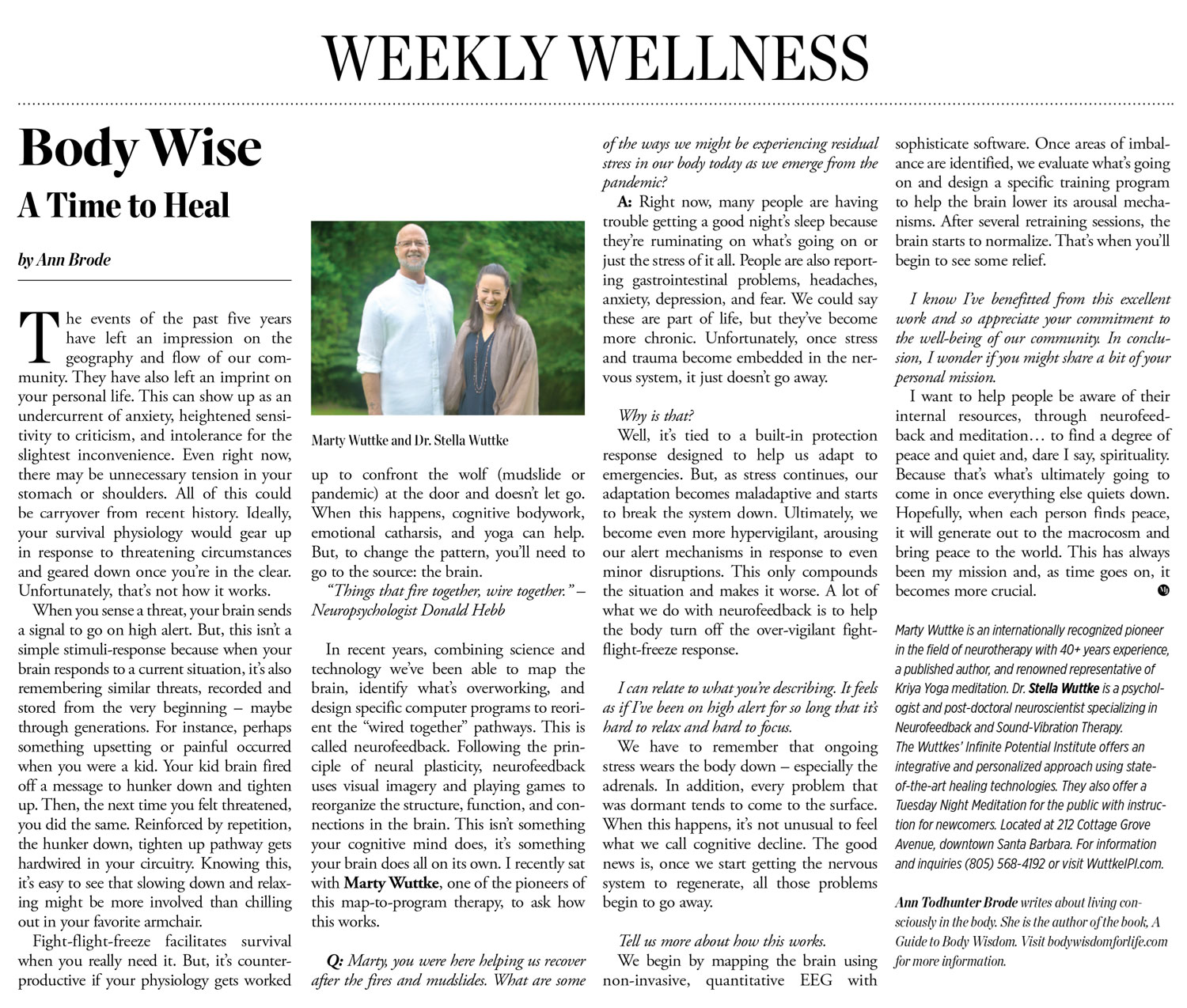
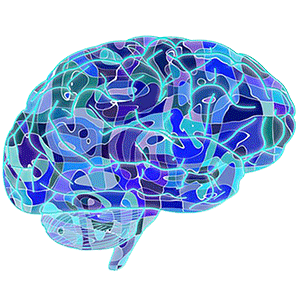
"Revolutionary Program Uses Neurofeedback to Reduce Parolee Returns to Prison"
Published in Trillions, February 2019
At the groundbreaking Wuttke Institute of Neurotherapy in Santa Barbara, California, a program is under way which could change everything we think and do with those we put in prison forever. (https://www.trillions.news)
It’s called the Neurofeedback Recidivism Reduction Project. As the creators of the project have described it, it “is a privately-funded, four-year, random control trial, designed to determine if neurofeedback training can reduce recidivism.” It is studying a total of 360 selected high-risk parolees, with half receiving guided neurofeedback and half as a control group. The goal of the program is nothing less than changing forever the way we care for those who may end up in prison, are in prison, and are helped after prison. It was created in partnership between Community Solutions, Inc., and the Wuttke Institute.
Marty Wuttke, the founder of the Wuttke Institute, brings the basic idea driving the work into a simple concept: it’s about “focusing on fixing the brain” using decades-proven neurofeedback methods.
Mr. Wuttke himself has extensive experience in the field. He was was affiliated with Ridgecrest Hospital and Woodridge Psychiatric Hospital from 1984 to 1995, where – as his website explains – he designed and directed the first large-scale in-patient neurofeedback program in the United States. During those 11 years, more than 1,500 patients went through his neurofeedback training efforts. Since then, he has dramatically expanded that same category of work through the Wuttke Institute, treating everything from depression to traumatic brain injury, nicotine dependence, eating disorders, chronic pain, anxiety, chemical dependency and alcoholism.
We spoke with Mr. Wuttke in December 2018 about the Recidivism Reduction Project at his offices in Santa Barbara, California.
Trillions: How did you get involved in the Recidivism Reduction Program in the first place?
Marty Wuttke: There’s a local community center non-profit organization called Community Solutions, Inc. I believe there’s about 16 of them scattered around the United States. The main headquarters is in Hartford, Connecticut.
It was founded by a fellow whose mission was these poor guys who get out of prison. They’re given a stipend of $20-$30-$40, and then just turned out on the street. He saw the problem. He saw the need. He actually started taking people into his home there in Connecticut.
From that involved Community Solutions, Inc., which is sort of a stepping stone for guys after they get out of prison and are on parole. They wanted to learn skills, tools to integrate back into society.
There’s one here in Santa Barbara and another one in Northern California, in Santa Maria. A local fellow who is a retired philanthropist here decided that he wanted to get Community Solutions really going, and through Community Solutions, bring the recidivism rate down.
Recidivism is basically how soon [or ever] a parolee goes back to prison. The statistics vary quite a bit around the U.S. You see a lot of numbers thrown out. 65% of all parolees end up back in prison. Some studies show more, some studies show less, but it’s not great. Every time a person recidivates, it costs the state somewhere between $80,000 and $100,000, because of all the ancillary costs.
So this local philanthropist decided that he wanted to make an impact. He started to pursue me and see if there was some way that I felt I could create a program for them.
There [are] some precedents. Neurofeedback has been used in a prison in Ontario, Canada, many years ago. Nobody’s done a controlled study looking at recidivism and neurofeedback over time.
There were considerable bureaucratic and government hurdles to surmount. This philanthropist spent, I think, three years going through boards and meeting with government lawyers and sheriffs’ offices and so on. And sure enough, last January [2018] the program was okayed.
We have a very large study. We have a very good staff who are helping me with the program. We can already see that the parolees who are getting neurofeedback are changing very rapidly. This goes back to my hypothesis, the title of a book out there, “Change Your Brain, Change Your Life”.
If you’re going to really rehabilitate somebody, no matter if they were a criminal, [subjected to] post-traumatic stress disorder, or substance abuse you’ve got to focus on fixing their brains or bringing the function up to optimal. When the brain’s function is up to optimal, you see various issues and problems begin to be handled better.
It’s subtle. I just gave a lecture the other day. What you see with many people – it isn’t just parolees – many of us are driven by our limbic systems, by the parts of the brain that have to do with primitive impulses, survival, fight or flight responses, competition, and so on. Many of us “know better” than what we do. Knowing better comes from cortex, the neo-cortex, the outer shell of the brain and the more evolved part of the brain. The limbic system is less evolved.
What my hypothesis was that if we can get the limbic system to quiet down, so the person isn’t constantly living in a threat or survival response, that in effect the cortex will work better. That means better thinking, better impulse control, better motivation and so on. Because in many respects, the limbic system holds the cortex hostage. You see it everywhere. It’s in politics, it’s in marketing, etc.
Our hypothesis is testing out. It’s too early to say we’re going to see a massive reduction recidivism. [But] what we’re already seeing is real changes in the parolees who are going through the neurofeedback training. It’s very nice to see. I think it’s starting to take on a lot of interest by various groups around California and around the country. I have a feeing we’re going to see this spread out fairly quickly.
Trillions: That’s terrific news. How long have you been running this program?
Marty Wuttke: This is the first year. The goal is a total of 360 parolees. Half that number will be a control group. To get through scientific scrutiny, especially if you’re publishing, you have to have a control group. [That’s] so you can say the only difference between these two groups is that this group had neurofeedback, and therefore a reduction in recidivism would correlate with the fact that they did neurofeedback.
We’ve been at this for four years, but the program only started last January [2018]. So we’re coming into our first year, and then we’ve got a couple more years to go to meet our numbers.
All the parolees that are involved in this are volunteers. Nobody’s forced into this. It is completely at their discretion. Eventually, we’ll see about not just getting neurofeedback services to these fellows when they’re out of prison but getting neurofeedback services to them when they’re in prison. [We also want to work on this] even before that starting to get the adolescents and adolescents who are at risk and so on and start trying to head off these problems as early as we can.
Trillions: Was there any criteria you used to select these individuals, other than that they were all volunteers?
Marty Wuttke: We use high-risk offenders. There’s something called an LSRI score. When [the parolees] go in these halfway houses for Community Solutions, Inc., they meet with a staff member there. The staff member, through [the use of] a number of measures and questions, determines how at risk they are for re-offending. We choose high-risk re-offenders. We also, according to research guidelines, have to match ethnicity and so on. Then the control group and the intervention group are randomized. We don’t pick and choose after a certain point, because that would be skewing the research, obviously.
We have a person who is a psychologist who is organizing the main part of the research, the Duke University social psychologist, and then my wife Stella, who is also a cognitive research psychologist. So she’s involved in the process as well.
It’s a very well-designed study. There’s no ambiguity about it.
Trillions: This sounds like it’s well-enough structured so it may propagate quickly afterwards.
Marty Wuttke: The goal is to get this into the rehabilitation system, because it’s broken – at least here in the U.S. It’s quite clear that incarceration and punishment doesn’t solve the issues. We have to start bringing in other methods and means. Primarily my method and means is trying to re-stabilize the brain, and get it back into a level of function that it may not have been in. Not to mention all the head injuries, drug overdoses, and neurodevelopmental issues these guys have. All those respond to neurofeedback quite well.
Trillions: When do you feel there will begin to be public disclosure of any results of this?
Marty Wuttke: Probably not for another year or so. We have a very interesting thing happening here in Santa Barbara. Anybody who is familiar with Santa Barbara knows it is an exclusive community. There’s lots of philanthropists, lots of foundations here. We actually have something called an observation group, which is a group of foundations and leaders of foundations and physicians who we meet with now quarterly. There are judges too watching us. We go over what we’re seeing, what the progress is, the problems, and mostly the solutions. We are keeping everyone abreast who’s interested [in] our progress.
We just had a meeting last week. Everybody’s so interested in this, and it’s not just for parolees. I work with everything from kids with autism to adults who want to learn how to meditate better and everything in between. I put this in an orphanage in Ukraine several years ago, so neurofeedback has lots of applicability.
What I’m saying is these foundations who are watching us have other interests [besides just the parolees]. Women with abuse issues, post-traumatic stress disorder. The opioid epidemic is out of control right now. Veterans from the military, and so on. So, we have representatives from many foundations who are focused on these different areas.
What they’re saying is, “We don’t want to wait five years for your research to be finished before we start neurofeedback training. We know it works. We’ve seen it. We believe in it. How can we get going right now?”
So right now I’m scrambling to create a way to support quite a variety of organizations, to get neurofeedback going within the organization, within the various locations, treatment centers, and hospitals. That’s starting immediately.
People have been watching neurofeedback for many years. Yeah, there’s still some that need to be convinced. But for most people, the evidence is there. There are several books written on it now, so people are, like, “It’s here. Let’s use it if we can apply it in our specific population.”
That’s what we’re doing now. We’re even offering remote neurofeedback, which has been quite effective. That’s simply where people contact my office, and they say, “I want to do neurofeedback but I don’t want to fly all the way out there to Santa Barbara, and I can’t find anybody in my community who does it. Can you help me?”
We send them the equipment. I have technicians who make appointments with them. They rent [the equipment] for a month or so. Our technicians video Skype or VC with them, and they do their sessions. It’s been quite effective. I’ve been able to treat people from all around the world this way. I’m happy with that, and people love not having to get out of their living room and fly over to Santa Barbara to do it.
The application of neurofeedback is spreading dramatically. What I’m just trying to do is to keep up with it. I’ve had to hire lots of staff just to get in line with this.
The parolee project will be a significant outcome, we hope, for the government and more traditional academia. The University of Long Beach, California, is involved with it now. They’re going to do a statistical analysis for us, which brings another level of credibility to the whole project.
There’s a lot that’s going to happen in terms of the spread of neurofeedback before the four years are up.
Source: Trillions, 02/07/2019 AT 20:06 PM, https://www.trillions.news/news/154404-Revolutionary-Program-Uses-Neurofeedback-to-Reduce-Parolee-Returns-to-Prison.html.
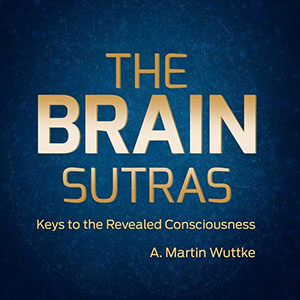
Marty's Book (2019)
The Brain Sutras: Keys to the Revealed Consciousness
Available at our office in SB or on Amazon.
Science and spirituality will eventually merge as two complimentary views of reality pointing to the same conclusion: “Tat twam asi” (that thou art, or Absolute Consciousness is our essence of being, which has been stated in ancient Vedic texts. The Brain Sutras are an attempt to explain the relationship between consciousness and the brain and how this relationship manifests as our world and ourselves.
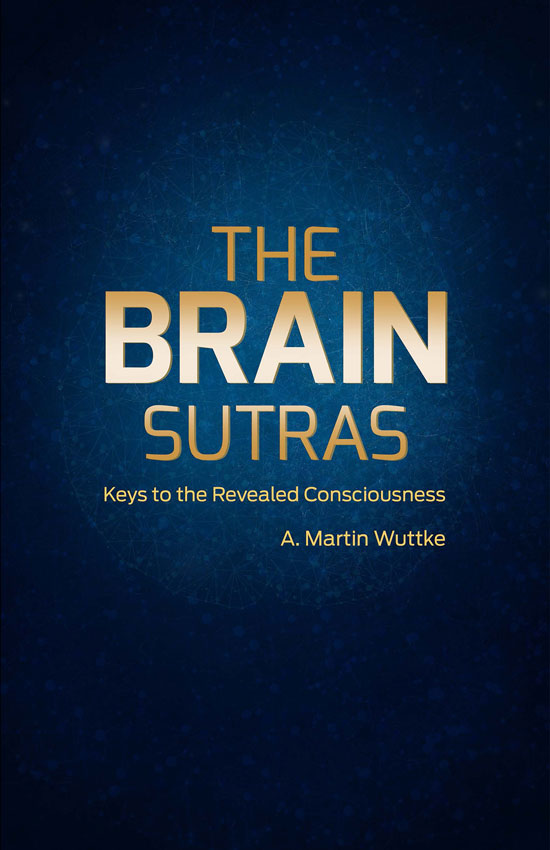
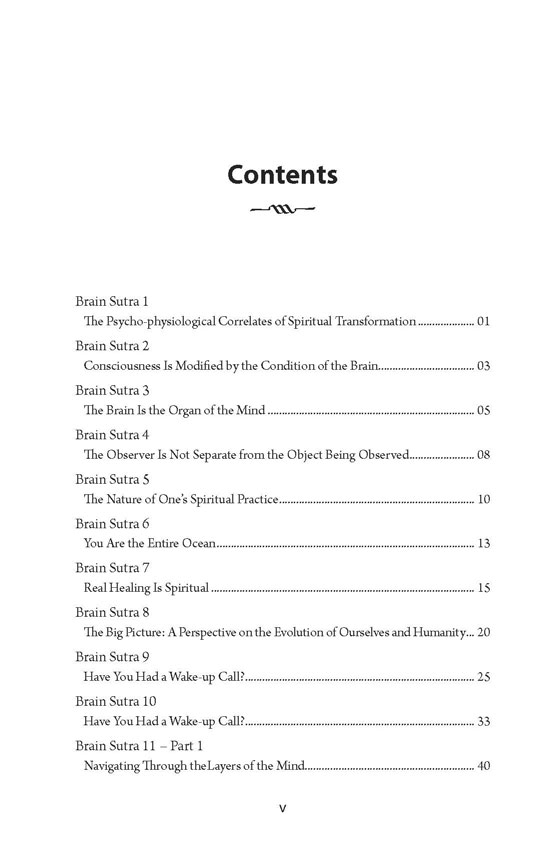


"Neurofeedback is an emerging method that relaxes, enhances creativity and improves mental health." by Blaine Greteman
Published in The Intelligent Optimist, Special Issue 2012, p. 7-14.
